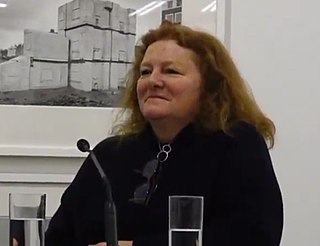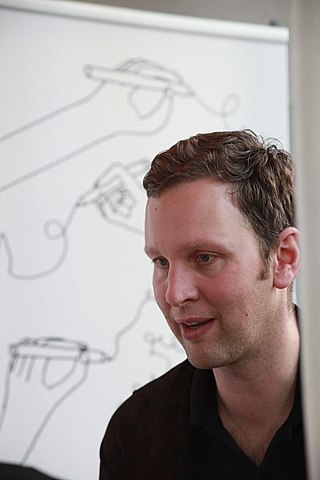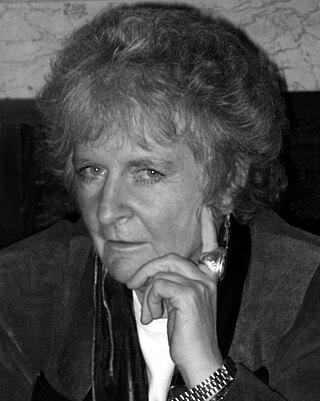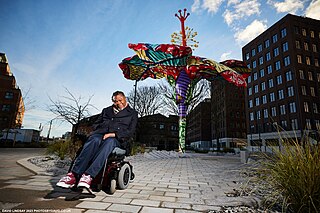
Trafalgar Square is a public square in the City of Westminster, Central London, established in the early 19th century around the area formerly known as Charing Cross. The square's name commemorates the Battle of Trafalgar, the British naval victory in the Napoleonic Wars over France and Spain that took place on 21 October 1805 off the coast of Cape Trafalgar.

Dame Rachel Whiteread is an English artist who primarily produces sculptures, which typically take the form of casts. She was the first woman to win the annual Turner Prize in 1993.

Marc Quinn is a British contemporary visual artist whose work includes sculpture, installation, and painting. Quinn explores "what it is to be human in the world today" through subjects including the body, genetics, identity, environment, and the media. His work has used materials that vary widely, from blood, bread and flowers, to marble and stainless steel. Quinn has been the subject of solo exhibitions at Sir John Soane's Museum, the Tate Gallery, National Portrait Gallery, Fondation Beyeler, Fondazione Prada, and South London Gallery. The artist was a notable member of the Young British Artists movement.

David John Shrigley is a British visual artist. He lived and worked in Glasgow, Scotland for 27 years before moving to Brighton, England in 2015. Shrigley first came to prominence in the 1990s for his distinct line drawings, which often deal with witty, surreal and darkly humorous subject matter and are rendered in a rough, almost childlike style. Alongside his illustration work, Shrigley is also a noted painter, sculptor, filmmaker and photographer, and has recorded spoken word albums of his writing and poetry.

Margaret J. Hambling is a British artist. Though principally a painter her best-known public works are the sculptures A Conversation with Oscar Wilde and A Sculpture for Mary Wollstonecraft in London, and the 4-metre-high steel Scallop on Aldeburgh beach. All three works have attracted controversy.

Yinka Shonibare, is a British artist living in the United Kingdom. His work explores cultural identity, colonialism and post-colonialism within the contemporary context of globalisation. A hallmark of his art is the brightly coloured Ankara fabric he uses. As Shonibare is paralysed on one side of his body, he uses assistants to make works under his direction.

Events from the year 1999 in art.
Imagine is a wide-ranging arts documentary series first broadcast on BBC One television in 2003, hosted and executive produced by Alan Yentob. Most series consist of 4 to 7 episodes, each on a different topic. Episodes have been directed by, among others, Geoff Wonfor, Lucy Blakstead, Jill Nicholls, Roger Parsons and Zoë Silver.
Child of Our Time is a documentary commissioned by the BBC, co-produced with the Open University and presented by Robert Winston. It follows the lives of 25 children, born at the beginning of the 21st century, as they grow from infancy, through childhood, and on to becoming young adults.

Thomas Schütte is a German contemporary artist. He sculpts, creates architectural designs, and draws. He lives and works in Düsseldorf.
Sokari Douglas Camp CBE is a London-based artist who has had exhibitions all over the world and was the recipient of a bursary from the Henry Moore Foundation. She was honoured as a Commander of the Order of the British Empire (CBE) in the 2005 Birthday Honours list.

One & Other was a public art project by Antony Gormley, in which 2,400 members of the public occupied the usually vacant fourth plinth in Trafalgar Square, London, for an hour each for 100 days. The project began at 9 am on Monday 6 July 2009, and ran until 14 October. The first person to officially occupy the plinth was Rachel Wardell from Lincolnshire. A documentary art book by Gormley, entitled One and Other, was published in the UK by Jonathan Cape on 14 October 2010. The Wellcome Trust has posted online at its website its series of oral-history interviews of the 2,400 plinthers.

The fourth plinth is the northwest plinth in Trafalgar Square in central London. It was originally intended to hold an equestrian statue of William IV, but remained empty due to lack of funds. For over 150 years, its use was debated; in 1998, the Royal Society for the encouragement of Arts, Manufactures and Commerce (RSA) commissioned three contemporary sculptures to be displayed temporarily on the plinth. Shortly afterwards, Chris Smith, Secretary of State for Culture, Media and Sport, commissioned Sir John Mortimer to seek opinions from public art commissioners, critics and members of the public as to its future. Mortimer's final report recommended that there continue to be a rolling programme of commissioned temporary artworks rather than settle permanently on one figure or idea.
Peter Maurice Hull, MBE is a British Paralympic gold medalist.

Hahn/Cock is a sculpture of a giant blue cockerel by the German artist Katharina Fritsch. It was unveiled in London's Trafalgar Square on 25 July 2013 and was displayed on the vacant fourth plinth. The fibreglass work stood 4.72 metres (15.5 ft) high and was the sixth work to be displayed on the plinth, on which it stayed until 17 February 2015. It was subsequently acquired by Glenstone, a private museum, and exhibited at the National Gallery of Art in Washington, DC, following its 2016 reopening. In March 2021, Glenstone permanently donated the piece to the National Gallery.

A bronze statue of Charles James Napier by the sculptor George Gammon Adams stands in Trafalgar Square in London, United Kingdom. It occupies one of the four plinths in Trafalgar Square, the one to the southwest of Nelson's Column.

Heather Phillipson is a British artist working in a variety of media including video, sculpture, electronic music, large-scale installations, online works, text and drawing. She was nominated for the Turner Prize in 2022. Her work has been presented at major venues internationally and she has received multiple awards for her artwork, videos and poetry, including the Film London Jarman Award in 2016. She is also an acclaimed poet whose writing has appeared widely online, in print and broadcast.

A Surge of Power 2020 is a 2020 black resin sculpture, sculpted by Marc Quinn and modelled on Jen Reid; both Quinn and Reid are credited as artists. It depicts Reid, a black female protester, raising her arm in a Black Power salute. It was erected surreptitiously in the city centre of Bristol, England, in the early morning of 15 July 2020. It was placed on the empty plinth from which a 19th-century statue of Edward Colston, who had been involved in the Atlantic slave trade, had been toppled, defaced and pushed into the city's harbour by George Floyd protesters the previous month. The statue was removed by Bristol City Council the day after it was installed.
Jen Reid is a British Black Lives Matter activist from Bristol. After the statue of Edward Colston was pushed into Bristol Harbour, Reid stood on the empty plinth and made a Black Power salute. This pose was then recreated in the sculpture A Surge of Power 2020.

Nelson's Ship in a Bottle is a sculpture by the British-Nigerian artist Yinka Shonibare. Commissioned in 2009 by the Greater London Authority, it was originally placed on the Fourth Plinth in London's Trafalgar Square in 2010.
















